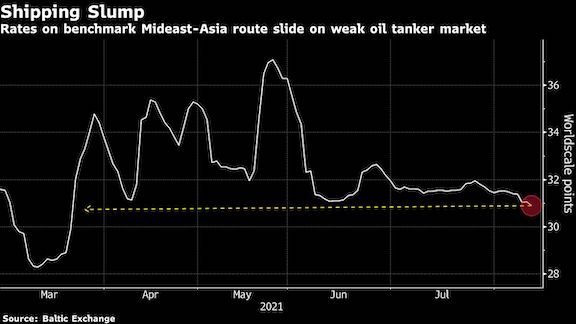The summer doldrums are here for oil supertankers.
Freight rates on the benchmark route from the Middle East to Asia have slipped to their lowest levels since March, meaning lower earnings for those vessels, Baltic Exchange data show. At the same time, ship-fuel costs have jumped.

The spread of the delta variant of the coronavirus has clouded the outlook for demand in Asia, the main market for Middle Eastern crude. Meanwhile, supply curbs in recent months by the OPEC+ alliance have reduced the amount of crude that’s needed to be shipped. In addition, scrapping of supertankers is low, with owners finding buyers on the secondary market.
Supertanker are now ballasting—sailing without cargoes—at slower speeds to cut their fuel consumption as they face higher fuel prices, according to analysis from Vortexa Ltd. Ships are traveling an average of almost 12% slower than they were at the start of the year, which translates into savings of $4,100 to $5,200 a day—depending on the type of fuel—according to the researcher’s calculations based on bunker prices in Singapore.
In the Asian shipping hub, prices for very-low sulfur bunker fuel are about 50% higher than they were at this time last year as the world has begun to recover from the pandemic, data from LQM Petroleum Brokers show.
The outlook for the next few months is mixed. While bunker fuel prices have slipped from their 2021 high in July, they still remain elevated.
The OPEC+ alliance is set to pump 400,000 more barrels a day of crude this month, which could increase exports. However, this “has yet to significantly boost tanker activity,” the IEA said, while lowering its oil demand outlook in general.
Several Asian refiners have asked for less oil from OPEC giant Saudi Arabia in September—a sign of the virus’s recent effect. At the same time, state-owned oil company Saudi Aramco gave full supplies for next month to at least nine customers in the region, according to refinery officials.
“Brokers pointed to Saudi Arabia allowing refining clients their full contracted volumes for September as a positive indication for improving trade volumes ahead,” Clarksons Platou shipping analysts said in a research note on Wednesday. “For now, however, rates remain steady.”











